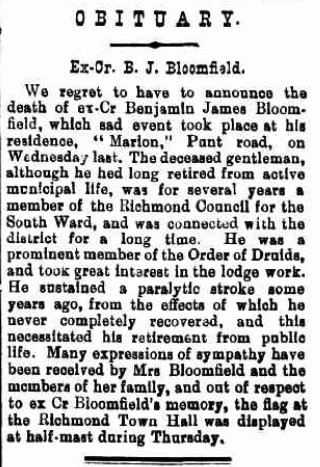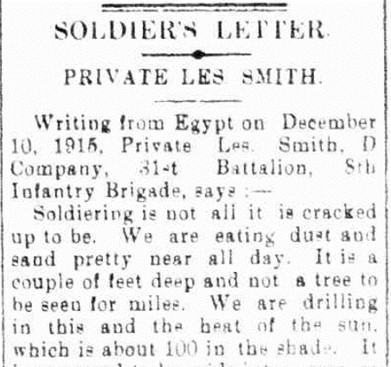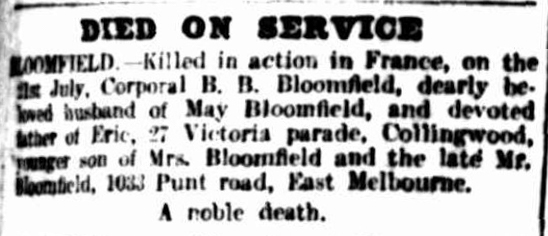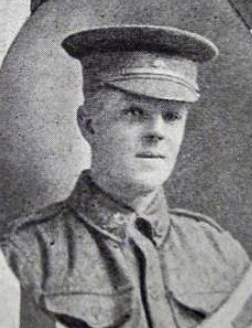
Bertram Benjamin BLOOMFIELD
Eyes light blue, Hair fair, Complexion fresh
Bert Bloomfield - An Interesting Life
Can you help us identify Bert Bloomfield?
Bert was Killed in Action at Fromelles. As part of the 31st Battalion he was positioned near where the Germans collected soldiers that were later buried at Pheasant Wood. There is a chance he might be identified, but we need help. We are still searching for suitable family DNA donors after many years of research.
In 2008 a mass grave was found at Fromelles, a grave the Germans dug for 250 (Australian) bodies they recovered after the battle. If you know anything of Bert’s contacts here in Australia or his Bloomfield relatives form Melbourne or Coddenham, Suffolk, or his mother’s Merryfull relatives from Melbourne and Exeter in Devon, please contact the Fromelles Association.
See the DNA box at the end of the story for what we do know about his family.
Early Life
Born in St. Kilda, Victoria on 1 June 1877, Bertram Benjamin Bloomfield was killed in the prime of his life, 39 years old, on 19-20 July 1916 in the Battle of Fromelles. Bert’s parents, Benjamin James and Mary Ann (nee Merryfull) Bloomfield, were married in Liverpool, UK on 16 September 1869 and just a week later left for Melbourne on board the ship Thomas Stevens, arriving in Australia in November. They raised five children and became prominent Melbourne citizens. Bert’s father served as Councillor for Richmond and South Melbourne in 1891-1893 and, amongst other things, was outspoken in the council for his support for Federation. He also was a prominent member of the Order of Druids, and ‘took great interest in the lodge work’. Benjamin suffered a stroke, and he passed away in 1900.
His mother was also active in the community and had
“…given much time and labour to charitable work….and has been for over 20 years a member of the Ladies’ Benevolent Society....”
Bert attended Melbourne Grammar from 1891 to 1892. He began working as a clerk for Victoria Brewery, which later became part of one of Australia’s well-known companies, Carlton and United Breweries. He married Victoria May Cotton at Christ Church, South Yarra on 30 April 1902 and they received a “handsome walnut buffet” given to the bridegroom by the officers, travellers and employees of the Victoria Brewery, East Melbourne, where
“…Mr. Bloomfield had been employed for nearly ten years….”
Bert and May’s son, Eric, was born in 1907. By 1909 Bert had moved on and became the proprietor of the Grantham Hotel at 243 William Street, Melbourne. This is an address steeped in Melbourne’s colonial history as it was the treasury that received the first gold escort in 1852.
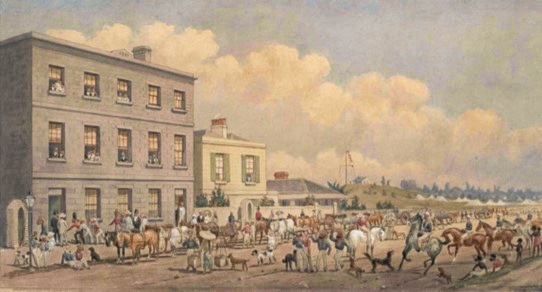
by William Austin
Bert’s time as proprietor of the Grantham Hotel didn’t last long, however. In May 1907 the government, under influence of both the temperance movement and women’s movements, was working to stamp out the social problems caused by excessive alcohol and was reducing the number of licenced premises in Victoria. Bert sold the hotel in March 1911. After this change of circumstances,
Bert and May lived apart, but nearby, between 1911 and 1914. May had moved in with her sister, Mary Ann Spry. She moved in with Mary again when Bert went to the War in 1915. In the two years prior to enlisting in the Army, Bert worked as a brewer’s assistant, although he lists his occupation as a typist when he enlisted.
Off to War
At 38 years old, Bert felt the call to duty and enlisted in early July 1915. He was assigned to the newly formed 31st Battalion, C Company. The 31st Battalion was formed with two companies from Queensland and two companies from Victoria. Victorian enlistees trained at the camp at Flemington Depot and then at Broadmeadows. All were joined in early October at Broadmeadows in Victoria. Before sailing from Melbourne on 9 November aboard the troopship Wandilla, the 991 soldiers of the 31st had been on parade in Melbourne in front of a good crowd. The Minister for Defence, H.F. Pearce said:
I do not think I have ever seen a finer body of men.
While enroute, Bert was promoted to Corporal. The Wandilla docked at Port Suez exactly four weeks after leaving Melbourne. Bert’s battalion was first sent to Serapeum to continue their training and to guard the Suez Canal. Near the end of February, they moved to the large camp at Tel el Kebir. The 60 km trip must have been unpleasant, as it was reported that they were moved in ‘dirty horse trucks’.
Source AWM4 23/48/7, 31st Battalion War Diaries, Feb 1916, page 5
The next move was at the end of March, back to the Suez Canal at the Ferry Post and Duntroon camps and then finally to Moascar at the end of May. The months passed in training and sightseeing, but by the time the 31st Battalion was transferred to France, the men were all heartily sick of Egypt. Private Les Smith’s (934) letter home pretty well sums it up.
To the Western Front and Fromelles
On 15 June, the 31st Battalion began to make their way to the Western Front, first by train from Moascar to Alexandria. Bert’s C company sailed to Marseilles on the Manitou. After disembarking on 23 June, they boarded trains to Steenbeque and marched to Morbecque, 35 km from Fleurbaix, arriving on 26 June. The battalion strength was 1019 soldiers. Training continued, now with how to handle poisonous gas included in their regimen. They began their move towards Fleurbaix on 8 July and by 11 July they were into the trenches for the first time, in relief of the 15th Battalion.
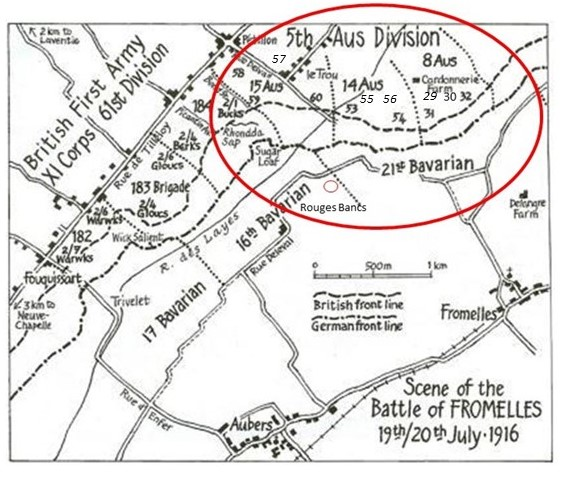
The original attack was planned for the 17th, but bad weather caused it to be postponed. On the 19th they were back into the trenches and in position at 4.00 PM. “Just prior to launching the attack, the enemy bombardment was hellish, and it seemed as if they knew accurately the time set.”
Source AWM4 23/48/12, 31st Battalion War Diaries, July 1916, page 23
The assault began at 5.58 PM and they went forward in four waves, A and Bert’s C Company in the first two waves and B and D Companies in the 3rd and 4th waves. The pre battle bombardment did have a big impact and by 6.30 PM the Aussies were in control of the German’s 1st line system (Trench B in the diagram below), which was described as “practically a ditch with from 1 to 2 feet of mud and slush at the bottom”. Source AWM4 23/49/12, 32nd Battalion War Diaries, July 1916, page 11

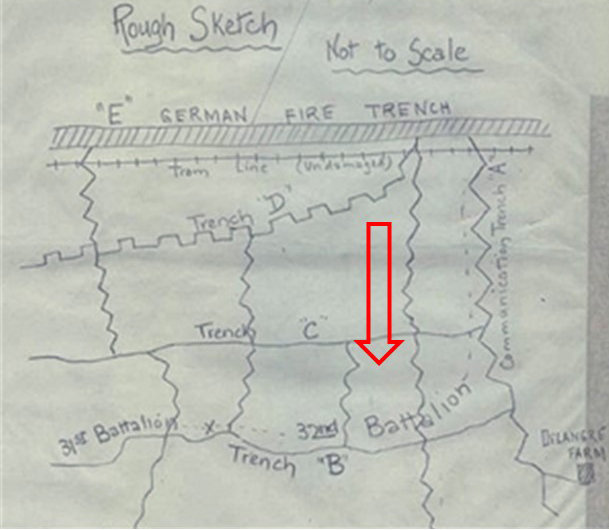
Unfortunately, with the success of their attack, ‘friendly’ artillery fire caused a large number of casualties. By 8.30 PM the Australians’ left flank had come under heavy bombardment with high explosives and shrapnel. Return bombardment support was provided and the 32nd, who also had the job of holding the flank to the left of the 31st, were told that:
“the trenches were to be held at all costs”.
Fighting continued through the night. The Australians made a further charge at the main German line beyond Trench B, but they were low on grenades, there was machine gun fire from behind from the emplacement at Delangre Farm and they were so far advanced that they were getting shelled by both sides. At 4.00 AM the Germans began an attack from the Australian’s left flank, bombing and advancing into Trench A (map). Given the Australian advances that had been made earlier, portions of the rear Trench E had been left almost empty, which then enabled the Germans to be in a position to surround the soldiers. At 5.30 AM the Germans attacked from both flanks in force and with bombing parties. Having only a few grenades left themselves, the only resistance the 31st could offer was with rifles:
“The enemy swarmed in and the retirement across No Mans’ Land resembled a shambles, the enemy artillery and machine guns doing deadly damage.”
The 31st were out of the trenches by the end of the day on the 20th. From the 1019 soldiers who left Egypt, the initial impact was assessed as 77 soldiers were killed or died from wounds, 414 were wounded and 85 were missing. The bravery of the soldiers of the 31st was well recognised by their own Battalion commanders.
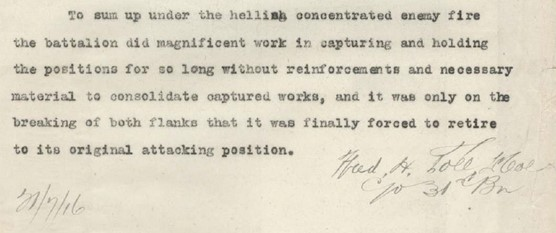
To get some perspective of the battle, when Charles Bean, Australia’s official war historian, attended the battlefield two and half years later, he observed a large amount of bones, torn uniforms and Australian kit still on the battlefield. The ultimate total was that 161 soldiers were either killed or died from wounds and of this total. 82 were missing/unidentified.
After the Battle - What happened to Bert?
There are no Red Cross or other reports in Bert’s files about his death or last sighting by his mates. Many were killed as they advanced, but many did advance into the German trenches.
Bert’s case is unusual, however:
- There is a handwritten statement and a map reference of him being ‘buried at Fleurbaix’, but there are no details of him being buried. Other unidentified soldiers from the 31st have this in their files as well.
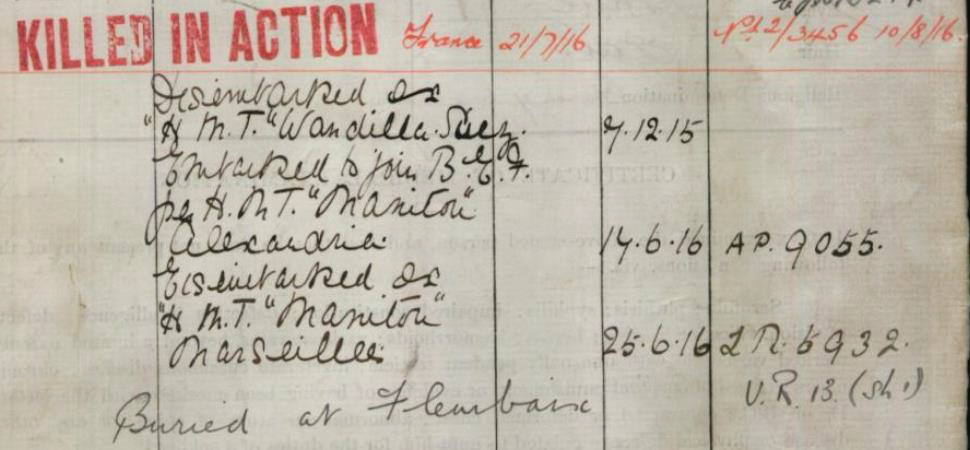
- The official report of his death states he died on 21 July…AFTER the battle. A number of soldiers from the 31st have this later date as well.
- The official record of his death was dated 16 August 1915 and his death was communicated to his family. With no known record of his death/burial, presumably he would have been declared as missing, not killed. The Army was very particular about not making statements of a soldier’s death until all possible avenues of searches were complete – hospital somewhere, prisoner of war, being on the German Death List, etc. Most of the soldiers who were missing in action from the battle were not declared as killed in action until mid-1917. There must have been some unrecorded detail of his death to allow the Army to make this declaration.
News about Bert did get back home and a family notice was posted on 16 August 1915 – “A Noble Death”.
Bert was awarded the British War Medal, the Star Medal, the Victory Medal and a Memorial Scroll and a Memorial Plaque.
With his official date of death recorded as 21 July, he did not ‘qualify’ to be commemorated at the VC Corner Memorial and was instead commemorated at Villers Bretonneux memorial. From research done over 100 years later, Bert and all of his mates who had the same administrative mistake about their date of death are now included on Panel 118 at the VC Corner Memorial.
Might Bert Still be Found?
As mentioned, there are no details about Bert’s position in the battle and he did not appear on any of the German Death Lists to suggest his body was recovered and identified by the Germans. However, the Germans had dug a mass grave that was found in 2008 that contained the remains of 250 Australian soldiers. This grave was in the vicinity that the 31st was fighting. Through DNA matching from family donors, as of 2024, 180 of these soldiers have been able to be identified, including 23 of the 82 originally unidentified 31st soldiers. Five of those found at Pheasant Wood have ‘buried at Fleurbaix’ in their file and 16 yet unidentified soldiers also have this annotation.
The identified soldiers are now properly buried at the Pheasant Wood Cemetery. Bert could be among the remaining unidentified soldiers. We need to find family DNA donors to find out. Please contact the Fromelles Association if you know of any connections to Bert’s family here in Australia or in the UK.
No DNA samples are held, and samples are being sought from family of Bert’s parents Benjamin James and Mary Ann (nee Merryfull) Bloomfield, and his siblings.
| Soldier | Bertram (Bert) Benjamin Bloomfield (1877-1916) | KIA Fromelles |
| Parents | Benjamin James Bloomfield (1839-1900) born Coddenham Suffolk. and Mary Anne Merryfull (1843-1931) born Exeter Devon |
| Siblings | Montague James (1872-1929), married Gertrude Whie – one son Royston | ||
| Beatrice Isabelle (1874 – 1936), m Fred Dobson, 6 children | |||
| Edith Margaretha (1874 – 1936), married Arthur Fewster 3 children | |||
| Maude (1884 – 1958), did not marry |
| Grandparents | |||
| Paternal | James Bloomfield (1814-1895) b Coddenham, Suffolk, England and Ann Baker (1814-1861) b Old Newton, Suffolk, England | ||
| Maternal | Grandfather unknown and Grandmother unknown |
Note. Bert married Victoria May Cotton and had a son Eric Grantham Bloomfield (1907-1993) Eric married and had son and daughter
The Fromelles Association would love to hear from you

Contacts
(Contact: carla@fromelles.info or geoffrey@fromelles.info).
(Contact: army.uwc@defence.gov.au or phone 1800 019 090).
Donations
If you are able, please contribute to the upkeep of this resource.
(Contact: bill@fromelles.info ).
